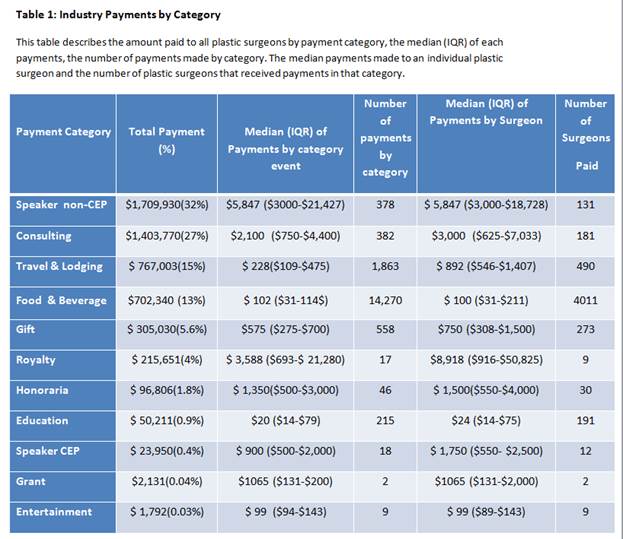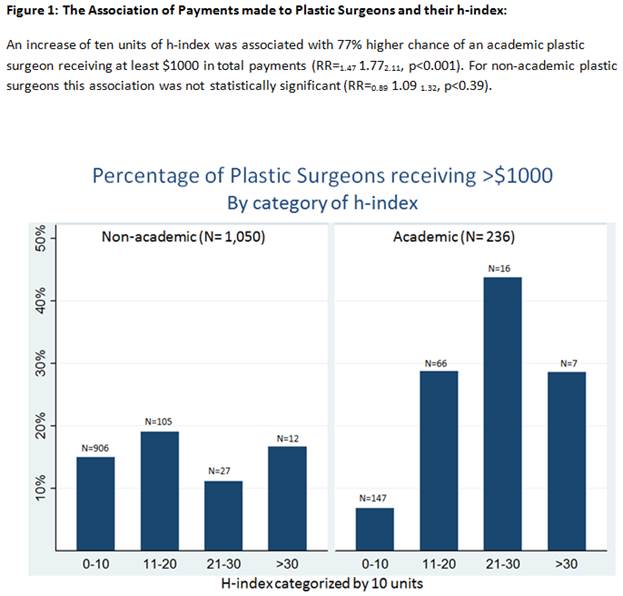|
|
|
|
|
Back to 2015 Annual Meeting
Where the Sun Shines: Industry's Payments to Plastic Surgeons
Rizwan Ahmed, MD, Joseph Lopez, MD, Sunjae Bae, MPH KMD, Allan B. Massie, PHD MHS, Karan Chopra, MD, Babak J. Orandi, MD PHD, James M. May, Jr., MD, Justin M. Sacks, MD PHD, Dorry Segev, MD PHD.
Johns Hopkins Hospital, Baltimore, MD, USA.
Where the Sun Shines: Industry's Payments to Plastic Surgeons
Background:
Physician Payment Sunshine Act (PPSA) is a recent government initiative requiring all biomedical companies to publicly disclose payments to health care providers (HCP), thus enabling patients to be aware of potential financial conflicts-of-interests (COI). Financial COIs have received considerable attention in the media. The purpose of this study is to provide a better understanding of the PPSA data in the context of plastic surgery as its interpretation or misinterpretation could potentially impact the future of physician practices and decision making.
Methods:
Using the first wave of PPSA data (Aug-Dec 2013), we studied the distribution of industry payments made to plastic surgeons nationally. We explored whether industry payments to plastic surgeons were associated with their practice setting and their scientific productivity, as measured by h-index.
Results:
During the five month reporting period, industry paid \,215,270 to 359,402 HCPs of which \,278,613 was paid to 4,195 plastic surgeons. 236 academic plastic surgeons received payments. Plastic surgeons received a median (IQR) of \(\-298); mean \,258. Among all plastic surgeons 45.8% received <\, 40.6% received payments between \-\, 11% received between \,000-\,999, 2.5% received between \,000- \,999, and 0.05% >\,000. The largest total payment to a plastic surgeon was \,384. The largest payment category was speaker bureau membership (\,709,930) followed by consulting fees (\,403,770). Private practice surgeons received higher payments per surgeon [median (IQR) \(\ - \)] compared to those in academics [median (IQR) \ (\-\)] (log-rank p<0.001). Among academic plastic surgeons, an increase of 10 units of h-index was associated with 77% higher chance of receiving at least \ in total payments (Poisson regression RR= 1.47 1.77 2.11, p<0.001). This association was not seen among plastic surgeons in private practice (RR= 0.89 1.09 1.32, p<0.39). 216 companies made payments to plastic surgeons. The three highest paying companies were Allergan Inc., Mentor Worldwide and Life Cell Corporation; they collectively contributed \,507,157 (66.4%) of all payments.
Conclusion:
Almost half of all plastic surgeons received payments <\. Plastic surgeons in private practice received higher payments. Among academic plastic-surgeons, higher payments were associated with higher h-indices. Awareness of the PPSA data are critical for plastic surgeons, as it provides a means to prevent potential public misconceptions about industry payments within the specialty.  
Back to 2015 Annual Meeting
|
|




